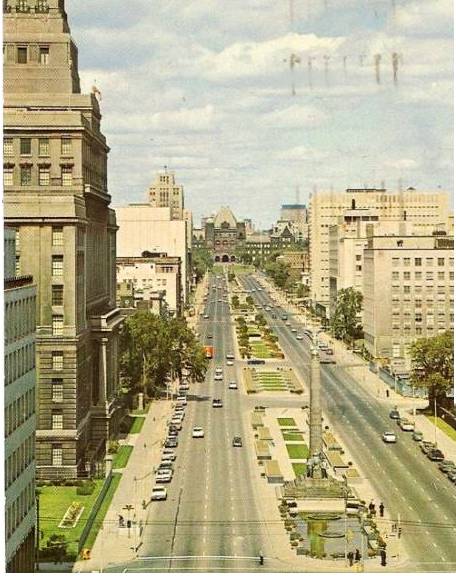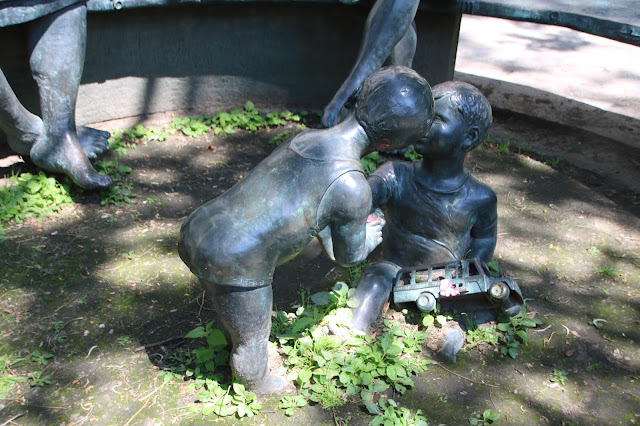I posted some other sculptures and historic buildings in this same area previously. University is an outside art gallery with more here.
You could make a day excursion just walking up University Avenue, postcard shows how it looked in the 1960s.
That is the Canada Life building on the left. At the top of the avenue is Queen's Park.

University Avenue is a major north-south road/ Beginning at Front Street West in the south, the thoroughfare heads north to end at College Street just south of Queen's Park. At its north end, the Ontario Legislative Building serves as a prominent terminating vista. Many of Toronto's most important institutions are located along the eight-lane wide street such as Osgoode Hall and other legal institutions, the Four Seasons Centre, major hospitals conducting research and teaching, and landmark office buildings for the commercial sector, notably major financial and insurance industry firms. The portion of University Avenue between Queen Street West and College Street is laid out as a boulevard, with several memorials, statues, gardens, and fountains concentrated in a landscaped median dividing the opposite directions of travel, giving it a ceremonial character.
1930s view - that red brick on the right near the front is the Armories that I mentioned in the linked post, the building was demolished to make way for the courthouse.

Princess Margaret Hospital
Along with the Odette Cancer Centre, which is also associated with University of Toronto Faculty of Medicine and is independently the sixth largest cancer centre in North America, it forms one of the largest cluster of cancer hospitals in the world.
An architectural firm was hired to restore the historic facade and integrate it into the new Ontario Cancer Institute.
This sculpture was created to honour those whom walked, volunteered or donated to the the Weekend to End Breast Cancer, a two-day, 60 kilometre walk to raise funds for breast cancer research at the hospital.
It sits outside Princess Margaret.
Toronto General Hospital
The moody bronze bas-relief standing outside Toronto General Hospital clearly depicts Edith Cavell. Edith Cavell was an English nurse working at a Red Cross hospital in occupied Belgium during the First World War when she was captured by the Germans. She was charged with treason for helping Allied soldiers escape and quickly executed in 1915.
It was considered one of the greatest atrocities of the war – her death fuelled recruitment drives and reassured British Toronto of the war’s necessity. But Florence Wyle’s sculpture, commissioned in 1919, quietly rises above propaganda’s noise. The calm, compassionate Cavell is linked with the Canadian nurses, “who gave their lives for humanity” and becomes a symbol of the caregiver’s desire to comfort the weary and wounded.
Behind the Toronto General Hospital.
Inner City Gate- Kosso Eloul, 1978
I also featured another sculpture by Eloul at the University of Toronto.
It was donated by Kleinburg artist Lea Vivot in remembrance of her son Morris who died in 1979.
Irish: síocháin, meaning "peace"
The bench itself has inscribed on the surface 470 names and messages from people known throughout the world including Mother Theresa, Menachem Begin, Indira Ghandi, Dr. Christian Barnard, Katherine Hepburn, Pierre Trudeau, a number of Canadian political and government leaders, and members of the hospital staff and the community.
Hospital for Sick Kids
"The Endless Bench," a 12-foot outdoor sculpture that depicts the bond between mothers and children has graced the front lawn of the University Avenue entrance to the hospital since its installation on July 7, 1984. The sculpture which is six feet in height, and weighing more than 3,000 pounds has been a centrepiece to hundreds of hospital events and a familiar landmark of SickKids.It was donated by Kleinburg artist Lea Vivot in remembrance of her son Morris who died in 1979.
Irish: síocháin, meaning "peace"
At the corner of the Hospital for Sick Kids is a sculpture done by
Meet Gladys Marie Smith. Born here in Toronto, she eventually changed her name to Mary Pickford when she became a Broadway star. Here, on the northeast corner of University Avenue and Elm Street.Born in 1893 in a house which stood near this site, Gladys Marie Smith appeared on stage in Toronto at the age of five. Her theatrical career took her to Broadway in 1907 where she adopted the name Mary Pickford. The actress's earliest film, "Her First Biscuits", was released by the Biograph Company in 1909 and she soon established herself as the international cinema's first great star. Her golden curls and children's roles endeared her to millions as "America's Sweetheart". She was instrumental in founding and directing a major film production company and starred in over fifty feature-length films including "Hearts Adrift", "Pollyanna" and "Coquette". For the last-named film, she received the 1929 Academy Award as the year's best actress.
Following two photos are from a Toronto Star article.
In a photograph taken in March 1924, Mary Pickford poses in front of the house on University Avenue where she was born in 1892. (CITY OF TORONTO ARCHIVES / CITY OF TORONTO ARCHIVES)

This photo, dated April 28, 1925, shows Mary Pickford's childhood home, to the right of the small one-storey house. (ALFRED J. PEARSON)






















I think we walked the length, or most of the very impressive civic street before finding Downtown Yonge. I especially remember the Hospital for Sick Kids and the Canada Life building.
ReplyDeleteMarvelous sculptures along this length of road. I've walked it on occasion.
ReplyDelete